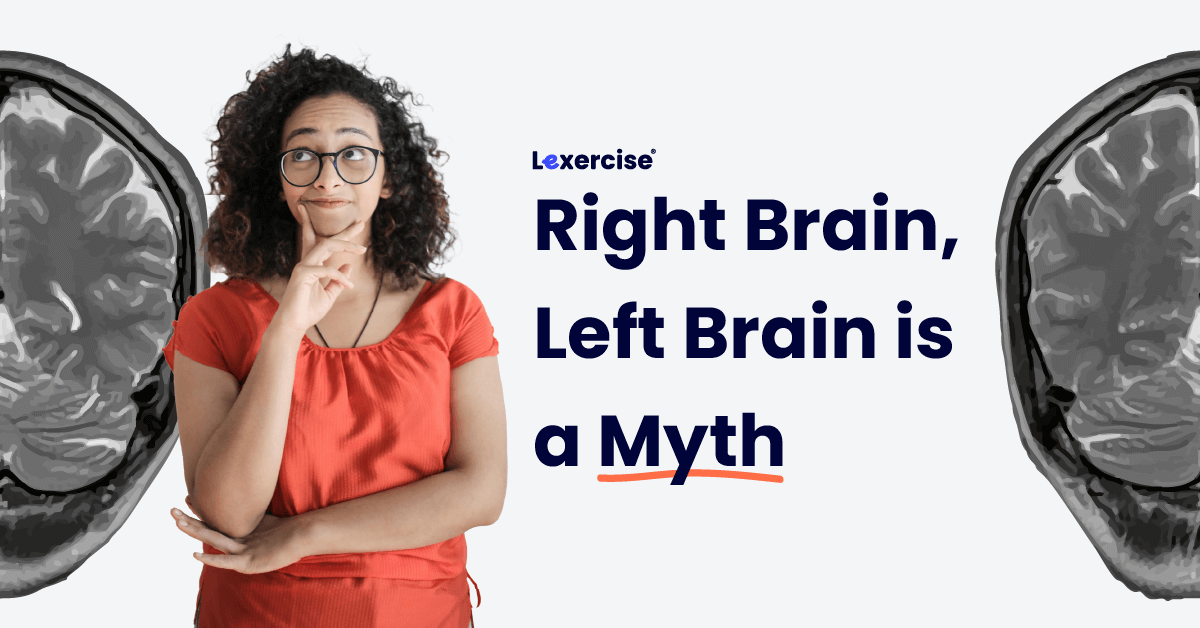Right-Brain, Left-Brain is a Myth
Written by Sandie Barrie Blackley, MA/CCC
Published on April 14, 2025

Some sources will say that personality and learning style differ according to what side of your brain is dominant– well that is a myth.
The reality is far more complicated, but getting the science right is essential for truly understanding our brains, how we learn, and how we can best educate ourselves and our children.
Let’s take a deeper look.
Left-Brained vs Right-Brained: Where Did the Myth Come From?
This myth of people being inclined to either right-brained or left-brained activities originated from the Nobel Prize-winning research of Roger Sperry in the 1960s. Sperry cut the brain along a structure called the corpus callosum in patients who have epilepsy and found out that the left and right sides of the brain could no longer communicate once that structure was cut.
He then did some studies and determined which sides of the brain were involved in different parts of thought. Psychology enthusiasts ran with this idea and convoluted it to mean more than it was meant to.
The neuroscience community never believed it, and now we have evidence from more than 1,000 brain scans showing absolutely no signs of left or right dominance.
 In an interview with braindecoder.com, Neil Degrasse Tyson, who is a popular scientist, completely shuns the theory. He thinks it was thrown into mainstream media as another attempt to categorize people rather than recognizing them as individuals.
In an interview with braindecoder.com, Neil Degrasse Tyson, who is a popular scientist, completely shuns the theory. He thinks it was thrown into mainstream media as another attempt to categorize people rather than recognizing them as individuals.
According to brainhq.com, brain scan technology has confirmed that the two sides complement each other. Scholars used to think that language processing only occurred in the left hemisphere, but now know that it occurs in both hemispheres.
The only part of the original claim that is accurate has to do with motor functions: The right side of the brain controls movement on the left side of the body and the left brain controls movement on the right side of the body.
How Left-Brain/ Right-Brain Doesn’t Help Children
Teaching kids that there’s a strict left-right divide can actually limit their potential by boxing them into artificial categories. Here are a few reasons why.
- Labeling a child as “not a math person” or “not creative” based on this outdated idea can discourage them from exploring new skills and growing into well-rounded learners.
- If a child who believes they are “left-brained” struggles with math or logic, or other “left-brained” activities they may conclude these skills are unchangeable and cannot be improved with effort, discouraging them from attempting to improve their skills.
- It ignores the reality that our brains are highly adaptable. We’re capable of changing, developing preferences for new subjects, enjoying new and different things, and constantly learning and growing.
The truth is that children’s brains are far more complex and interconnected than that simple right/left brain dynamic! In the years since the original right brain/left brain research, a new science of expertise has shown that skills and abilities are not fixed but can be developed through motivated, deliberate practice, and persistence.
Activities to Help Kids Understand How Our Brains Work
Looking for some activities to help your kids understand that their brains are far more complex than a simple left/right split? Here’s how you can help show the idea that both creativity and logic are essential in learning and life.
- The Math & Art Mashup
- Activity: Have kids create symmetrical drawings using graph paper or fold paper to make mirrored patterns. Use other “math” skills, like measuring and calculation, as you help create paper art.
- What It Shows: Math (logic and patterns) and art (creativity) work together, proving that numbers and creativity aren’t separate skills.
- The Logic Puzzle Story Challenge
- Activity: Give kids a short puzzle (like a riddle, a word problem, or Sudoku), then ask them to write a short creative story about how a character solves it.
- What It Shows: Problem-solving requires both logic (puzzle-solving) and imagination (storytelling), with one often working as a springboard for the other.
- The Music & Memory Test
- Activity: Play a song and have kids first analyze its beat and structure (counting beats, finding patterns), then ask them to describe the emotions it makes them feel.
- What It Shows: Music engages both analytical thinking (patterns, rhythm) and emotions (creativity, feelings).
- The Problem-Solving Build
- Activity: Give kids a set of materials (Lego, craft supplies, etc.) and challenge them to build something functional, like a bridge or a marble maze.
- What It Shows: Engineering requires both creative design and logical problem-solving, proving that no one is “just” left-brained or right-brained.
Lexercise: Helping Struggling Students Reach Their Potential
Lexercise is committed to helping students improve their literacy through science-backed, kid-friendly teaching strategies.
If you have questions about your child’s struggles, please schedule a free consultation. Alternately, if you are not sure whether your child has a reading problem, feel free to take our free dyslexia screener.
Improve Your Child’s Reading
Learn more about Lexercise today.
Schedule a FREE
15-minute consultation



Leave a comment